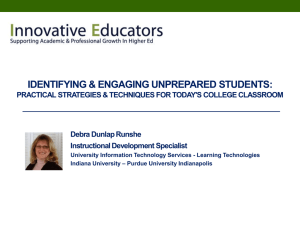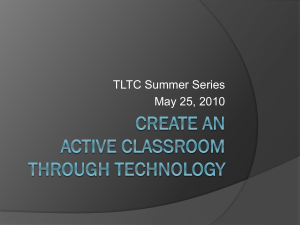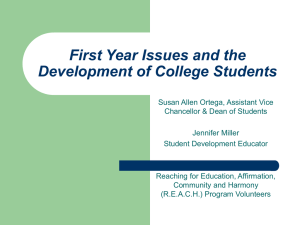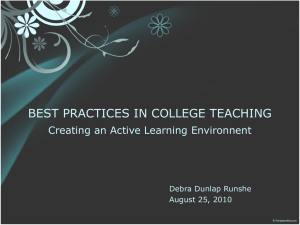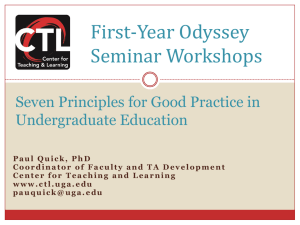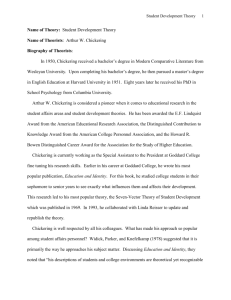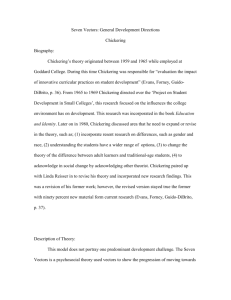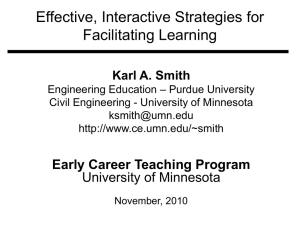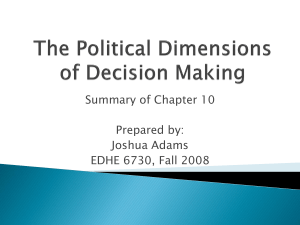Presentation
advertisement
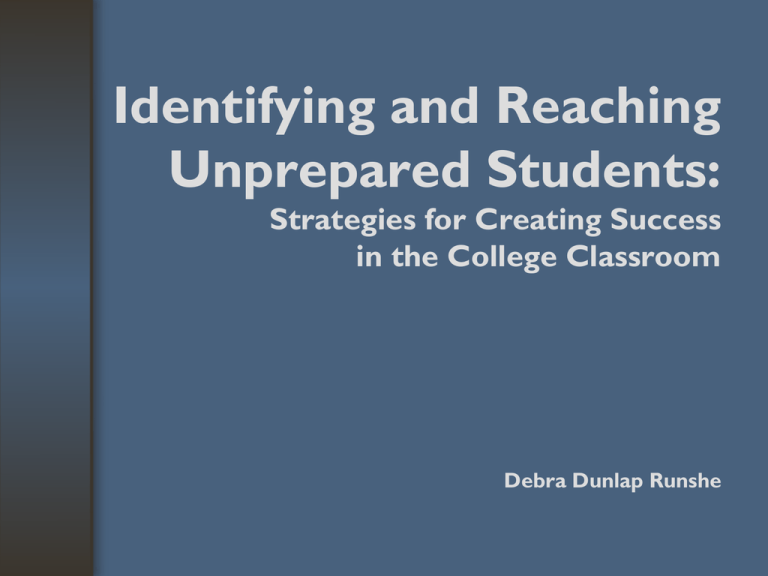
Identifying and Reaching Unprepared Students: Strategies for Creating Success in the College Classroom Debra Dunlap Runshe Goals for this session: By the end of this session, participants will be able to: recognize characteristics and/or behaviors of unprepared students. describe best practices to engage learners. identify techniques that can be incorporated into their classes that will lead to student success. Myth or Reality?? Unprepared? “The number of academically unprepared and at-risk student enrolling in colleges and universities is increasing.” Gabriel (2008) True or False ACT testing results showed that 49% of high school graduates do not have the reading skills needed for college success. At 4-year colleges, 25% of first-time students require at least 1 year of remedial courses. Once admitted to college, 75 % of the students who have to take at least one remedial class will not go on to obtain a degree or certificate within 8 years of enrollment Adelman, (2004); Horn & Berger, (2004); Kuh, Kinzie, Schuh, Whitt, & Associates, (2005) Unprepared and/or At-Risk Students: Characteristics and/or Behaviors Identifying Guidelines Low SAT or ACT scores High School GPA below 3.0 Might have ADHD or LD* Special Admit Identifying Activities Reading and Vocabulary Quiz Writing Sample Gabriel (2008) Four major reasons for academic difficulty: poor management of time continue to organize and study the same way as they did in high school selection of courses they studied alone … Light (2001) Study Skills Many students have never been exposed to … different ways to approach studying or even to the idea that there are different ways to study … We can help students learn about different strategies and when to use them. (p. 124) Svinicki, (2004) Congruence What should my students know? What should they be able to do? Outcomes What type of activities can help students achieve the learning outcomes? How will I know that they have achieved the outcomes? Activities Assessment Learning Outcomes: are provided at the course level. are provided at the individual module or unit level. are clearly stated. are measurable. are written from learner’s point of view. are appropriate for the target audience. are appropriate for desired skill level. require that students spend a portion of the course engaging in higher levels of learning, such as analysis, synthesis, and evaluation. Learning Activities: are aligned with the stated course outcomes. include thorough instructions, including a description of the activity and, if applicable, expectations of any student-generated materials, due dates, and a grading rubric. are appropriate for the target audience. are engaging, active and use a variety of instructional methods to accommodate diverse learning preferences. provide opportunities to apply course content to authentic activities. are designed to offer students opportunity for choice. Seven Principles for Good Practice 1. 2. 3. 4. 5. 6. 7. Encourages student-faculty contact Develops reciprocity and cooperation among students Uses active learning techniques Gives prompt feedback Emphasizes time on task Communicates high expectations Respects diverse talents and ways of learning Chickering & Gamson (1987) Principle 1: Encourages Student-Faculty Contact Suggestions: encourage classroom interaction establish rapport with students provide personalized feedback increase accessibility express interest in students participate in co-curricular activities The First Week of Class Begin with a detailed and explicit syllabus. Learn your students’ names. Strategies to accomplish this: name plates office hours “interviews” Gabriel (2008) Building Community Find someone who___??? Ukens (1997) Principle 1: Student-Faculty Online Connection Communication tools (email, discussion, chat, and web conferencing) can increase and strengthen student-faculty contact by: fostering more thoughtful responses. encouraging shy students to participate. providing more communication opportunities for commuter and part-time students. offering more time to read and formulate responses for ESOL students. Chickering & Erhmann (1996) Principle 2: Cooperation Among Students Suggestions: plan cooperative learning activities • group projects, presentations, or papers • study groups • peer tutoring • peer evaluation foster collaborative rather than competitive or independent environments Cooperative Learning Essential Ingredients positive interdependence individual accountability and personal responsibility social skills group processing Johnson & Johnson (1994) Cooperative Learning Applications learning new content peer review checking homework test preparation and review presentations and projects labs and experiments drill and review Johnson & Johnson (1994) Cooperative Learning Strategies match group size to activity • informal activity (2-4 students) • formal activity (4-6 students) set intermittent deadlines and offer continual feedback include self and peer assessment assign differentiated group or individual grades maintain the groups for the duration of the semester avoid forming groups which have only one woman or one minority Johnson & Johnson (1994); Millis & Cottrell (1998) Cooperative Learning Group Selection Long-term group selection criteria: • academic ability • class/work schedule • interest/skill level • learning style Short-term group selection criteria: • values or opinions • convenience • random Millis & Cottrell (1998) Cooperative Learning Group Selection Methods for selecting group members: student data sheet interest/knowledge/skills checklist learning style inventories structured lineup process corners three-step interview playing cards Millis & Cottrell (1998) Principle 2: Cooperation Online Connection Communication tools (email, discussion, chat, and web conferencing) can be used for: study groups collaborative learning activities group problem-solving group discussion Chickering & Erhmann (1996) Principle 3: Active Learning Suggestions: Interactive lectures Discussions and debates Student presentations Collaborative writing exercises Problem-based learning activities Case studies Role playing Simulations and games Active Learning Defined In the college classroom, active learning involves students doing things and thinking about the things they do. Chuck Bonwell Why Active Learning? Research suggests active learning strategies: more frequently engage students. lead to increased student achievement. enhance students’ metacognitive skills. Retention of Information After 24 hours, what percent of information is retained by students in a lecture environment? a. 5% b. 10% c. 20% d. 40% e. 50% Sousa (2001) Retention After 24 Hours 90 80 70 60 50 40 30 20 10 0 Lecture Reading Audio-Visual Demonstration Discussion Practice by Doing Teaching Others Teaching Method Sousa (2001) The Active Learning Continuum CATs simple Short, low-risk complex Longer duration, higher-risk (Bonwell & Sutherland, 1996) Principle 3: Active Learning Online Connection Types of technology tools which encourage active learning: learning by doing (simulations, interactive software, web research) time-delayed exchange (email & discussion) real-time conversation (chat & web conferencing) Chickering & Erhmann (1996) Principle 4: Prompt Feedback Suggestions: provide feedback that is: • timely • directive • specific • appropriate use peer review when appropriate Principle 4: Prompt Feedback Online Connection Examples of technology tools which facilitate prompt feedback: communication tools automated assessment Word Comments electronic portfolios Chickering & Erhmann (1996) Principle 5. Time on Task Suggestions: engage learners develop goals use class time wisely provide study suggestions post module/weekly checklists communicate clear expectations break down learning into small portions encourage students to develop time management skills The Science of Learning Teach for long term retention and transfer: practice and retrieval vary the conditions “re-represent” information in an alternative format construct knowledge based upon prior knowledge and experience chunk information motivation Halpern & Hakel (2003) Principle 5. Time on Task Online Connection Technology tools can: make study time more efficient make access to resources more efficient increase study time Chickering & Erhmann (1996) Principle 6: High Expectations Suggestions: foster supportive climate provide clear expectations of performance offer alternative assignments to meet individual students’ needs and interests provide models of outstanding student work hold yourself to the same standard of excellence offer intermediate feedback tolerate mistakes celebrate success Principle 6: High Expectations Online Connection Technology tools can communicate high expectations by: stating expectations explicitly and efficiently posting samples of work representing different levels of quality automating peer review posting detailed rubrics publishing exemplary student work Chickering & Erhmann (1996) Principle 7: Diverse Talents Suggestions: accommodate diversity teach to different learning preferences Felder-Silverman Model Students learn about their learning preferences and strategies that will assist them in being successful. Their preferences fall on a continuum between: active or reflective, sensing or intuitive, visual or verbal, and sequential or global. http://www4.ncsu.edu/unity/lockers/users/f/felder/public/Learning_Styles.html Principle 7: Diverse Talents Online Connection Technology tools can meet different learning styles by: providing a variety of learning experiences allowing students to work at their own pace providing varying levels of structure Chickering & Erhmann (1996) Questions References Adelman, C. (2004). Principal indicators of student academic histories in postsecondary education, 1972-2000: U.S. Department of Education. Washington, DC: Institute of Education Sciences. Angelo, T.A., & Cross, K.P. (1993). Classroom assessment techniques (2nd ed.). San Francisco, CA: Jossey-Bass. Bonwell, C.C. & Eison, J.A. (1991). Active learning: Creating excitement in the classroom. Washington, DC: School of Education and Human Development, George Washington University. Bonwell, C.C. & Sutherland, T.E. (1996). Using active learning in college classes: A range of options for faculty. San Francisco, CA: Jossey-Bass. Braxton, J.M. (2008). The role of the classroom in college student persistence. San Francisco, CA: Jossey-Bass/Wiley. References Chickering, A.W., & Gamson, Z.F. (1987). Seven principles for good practice in undergraduate education. AAHE Bulletin 39(7), 3-7. Chickering, A.W. & Ehrmann S.C. (1996, October). Implementing the seven principles: Technology as lever. AAHE Bulletin, 3-6. Felder, R.M. & Silverman, L.K. (1988). Learning and teaching styles in engineering education. Engr. Education, 78(7), 674-681. Gabriel, K.F. (2008). Teaching unprepared students: Strategies for promoting success and retention in higher education. Sterling, VA: Stylus Publishing, LLC. Halpern, D.F. & Hakel, M.D. (2003, July/August). Applying the science of learning to the university and beyond. Change, 35, 36-41. References Hatfield, S.R. editor; with David G. Brown ... [et al.]; and special sections by Martin Nemko, contributing editor. (1995). The seven principles in action: Improving undergraduate education. Bolton, MA: Anker Publishing. Johnson, D.W. & Johnson, R.T. (1994). Learning together and alone: Cooperative, competitive, and individualistic learning. 4th ed. Needham Heights, MA: Allyn and Bacon. Kuh, G.D., Pace, C.R. & Vesper, N. (1997). The development of process indicators to estimate student gains associated with good practices in undergraduate education, Research in Higher Education 38(4), 435-454. References Kuh, G. Kinzie, J., Schuh, J., Whitt, E., & Associates. (2005). Student success in college: Creating conditions that matter. San Francisco: Jossey-Bass. Light, R.J. (2001). Making the most of college: Student speak their minds. Cambridge, MA: Harvard University Press. Millis, B.J., & Cottrell, P.G. (1998). Cooperative learning for higher education faculty. Phoenix, AZ: Oryx Press. Svinicki, M.D. (2004). Learning and motivation in the postsecondary classroom. Bolton, MA: Anker Pub. Co. Sousa, D.A. (2001). How the brain learns: A classroom teacher's guide (2nd ed.). Thousand Oaks, CA: Corwin Press. Ukens, L.L. (1997). Getting together: Icebreakers and group energizers. San Francisco, CA: Jossey-Bass/Pfeiffer. Debra Dunlap Runshe Indiana University – Purdue University Indianapolis Center for Teaching and Learning 755 West Michigan Street, UL 1125 Indianapolis, IN 46202 Phone: 317-278-0589 Email: drunshe@iupui.edu
